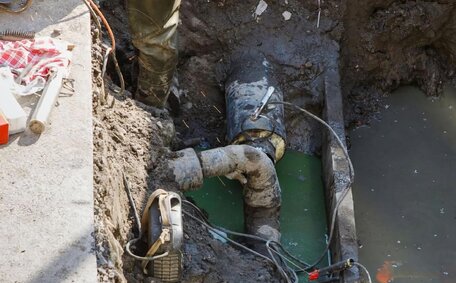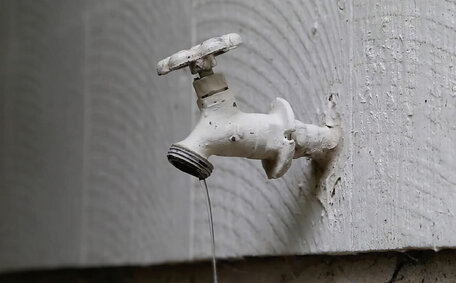Introduction to Water Hammers
This phenomenon occurs when the flow of water halts suddenly, sending a hydraulic shock wave through your plumbing system.
The shock wave from a water hammer can forcefully shake plumbing pipes against studs and joists. Over time, this noise can damage common pipe joints and connectors. The banging sounds are not just a nuisance but could signal potential problems ahead, because water energy transforms into sound and vibration.
For homeowners, noisy pipes prompting a call to a plumber for a water hammer fix are concerning due to potential safety risks and costly water damage. Identifying strategies on how to stop water hammer and applying fixes for the underlying causes can restore peace and quiet while preventing succeeding issues.
What Causes Water Hammers?
Understanding the causes of water hammer in your plumbing system is essential:
- Sudden changes in water flow - Abruptly turning off taps or valves stops water flow suddenly and can trigger water hammers. Rapid changes in water direction create a hydraulic shock wave, resulting in persistent hammering within the pipes.
- Quick-closing appliances - Washing machines, dishwashers, and other quick shut-off appliances can cause water hammer issues due to their rapid closure.
- Worn washers and valves that cause water hammers can be problematic; worn or broken faucet washers and shower valves in your home could lead to water being cut off too swiftly, thus triggering a shock wave through pipes.
- Air inside the system - Trapped air allows for the compression of water flow when ceasing, generating excessive pressure that gives rise to knocking.
- High pressure water systems - Excessive incoming mains water pressure can magnify the severity of water hammer events when water forcefully ceases within the pipes.
- Loose pipes - If your pipes water flow is not tightly secured, the shock waves can cause them to knock violently against joists and studs.
Understanding water hammer and its impacts equips plumbers to accurately identify and address specific issues.
Signs You Have a Water Hammer Problem
There are a few clear signs that may indicate you’re experiencing water hammer issues in your plumbing system:
- Loud banging sound or knocking emanating from pipes when shut off
- Banging vibrating noise that emanates from pipes and fixtures
- Vibrations perceived within your walls proximate to affected pipes
- An observable 'shock wave’ motion travelling along a pipe when water stops flowing
- Leaking or drips at connections points like elbows or joints
addressing the root cause of water hammer issues in your system is crucial to prevent damage and restore tranquillity in your home.
Don’t hesitate to connect with your local licensed plumber if you conclude that you’re grappling with a water hammer problem.
Potential Damage from Water Hammers
The ongoing shock waves striking your pipes can loosen fittings and water hammer your joints. Especially vulnerable are elbows, tees, couplings, and solder points. Consistent vibration can also cause cracks to form in the pipes themselves.
In certain scenarios, water hammering could cut off your water supply as pipes shudder loose from their anchoring straps or hangers. This leaves the water pipe unsecured and susceptible to breakage from the intense vibrations.
Water hammer-induced leaks in supply lines or fittings can introduce air into the system and result in expensive damage to walls, ceilings, and floors. Undetected leaks can ruin building materials and encourage mould growth.
Don’t wait until you have a major leak or pipe failure. Take proactive steps to diagnose the underlying cause of water hammers in your plumbing and implement water hammer solutions before the issues escalate.
Preventing Water Hammers
Preventing water hammers is achievable through correct installation and consistent maintenance of your plumbing system:
- Secure all pipes with pipe straps and hangers near the shutoff valve to minimise vibration and banging.
- Install water hammer arrestors near quick-closing fixtures in your system to absorb the shock effectively.
- Replace worn washers and water valves that shut off too abruptly.
- Ensure air chambers are properly charged to cushion the water pressure your pipes are subjected to.
- Use straps to isolate copper pipes from hitting other materials.
- Consider pressure-reducing valves if water pressure exceeds 80 PSI.
- Have a plumber routinely inspect your plumbing system.
- Instruct household members to turn off water gently at fixtures.
- Upgrade to appliances with slow-closing, water-efficient valves.
Installing Water Hammer Arrestors
Installing water hammer arrestors is a proactive measure to prevent them before they start. Water hammer arrestors are special valves that absorb the shock wave caused when water flow stops abruptly.
Water hammer arrestors should be installed near the supply pipes leading to rapid-closing fixtures like washing machines, dishwashers, and solenoid valves. This helps dissipate the shock right at the source.
- Turn off water at the main shut off valve for the water supply and drain the pipes.
- Shut off the water to the property, then cut the pipe and install the arrestor using threaded or soldered fittings.
- Make sure to turn off main water before checking that the arrow on the arrestor points in the direction of water flow.
- Secure the arrestor firmly to prevent vibration.
- Turn water supply back on slowly and check for leaks.
Installing arrestors near shutoff valves for sinks, toilets, and other fixtures can further protect your plumbing system. Reach out to a professional plumber if you require help with installing water hammer arrestors on your property.
A proficient plumber can install arrestors, taking proactive measures to preclude thousands in potential repairs to your hot water system.
Maintaining Proper Water Pressure
If the water pressure exceeds 80 psi, the force of water rushing through pipes and slamming closed valves can result in intense water hammer shock waves. On the other end, pressure lower than 50 psi can lead to complaints of weak flow at fixtures.
Here are some tips for maintaining optimal water pressure:
- Have a plumber check your home’s water pressure and make adjustments as needed.
- Install a pressure reducing valve if high water pressure exceeds 80 psi.
- Inspect your water pressure tank and recharge the air bladder if pressure drops below 50 psi.
- Check for clogged water filters or strainers blocking flow.
- Examine supply lines and faucet aerators for blockages.
- Upgrade old galvanised pipes, as mineral deposits can reduce inner diameter.
- Ensure the water metre and main shut-off are fully open.
Keeping water pressure within the optimal 50 to 80 psi range helps prevent water hammer and preserves your plumbing for long-term performance.
Have a plumber check your home’s water pressure and make adjustments as needed.Fixing Existing Water Hammer Issues
To resolve existing water hammer issues, identifand quick-closing valves. Consider methods to install water hammer arrestors, such as positioning them near problem fixtures. These components absorb the hydraulic shock when water flow suddenly stops. A pressure reducing valve can regulate high incoming water pressure, alleviating intense hammering. A pressure reducing valve can regulate high incoming water pressure, alleviating intense hammering. Start by checking for worn washers, loose pipes, and quick-closing valves that may be triggering the hammering. Diligence and skilled plumbing repairs can effectively resolve existing water hammer issues.
Reducing Water Pressure
If your home’s water pressure is too high, it can contribute to water hammer issues. One solution is to install a pressure limiting valve after the water metre to reduce incoming water pressure.
A pressure limiting valve can be preset to deliver water at lower, safer pressures. Adjustable valves enable you to fine-tune the pressure to an optimal range of 50-80 PSI.
Lowering the water pressure reduces the force on pipes and fixtures when flow stops, cushioning the hydraulic shock and minimizing pipe hammering.
Lowering water pressure may also mean you get less water flow from fixtures. But this is a worthwhile tradeoff to protect your plumbing system and prevent damage from water hammers over time.
Consider having a professional plumber assess your water pressure and determine if a pressure limiting valve installation is necessary.
Reducing Water Pressure
If your home’s water pressure is too high, it can contribute to water hammer issues.
Adjustable valves minimizing pipe hammering.
Retrofitting Air Chambers
In older homes that lack proper air chambers, installing an air chamber can help absorb hydraulic shock and mitigate water hammer occurpressure spikes when water flow stops suddenly.
Here are the steps for adding air chambers in pre-existing plumbing, starting with how to shut off the main water valve at this turned off before cutting into the hot water line to install a tee fitting.
Attach a 12-18 inch length of copper pipe to the tee.Cap the new copper pipe. This will serve as the air chamber.Make sure pipe connections are water-tight.Slowly turn the water back on and check for leaks.The air chamber should be installed as close as possible to the water supply line for maximum effectiveness. Periodically check that it remains properly charged with air.
Retrofitting air chambers provides an economical solution to mitigate water hammer in older plumbing systems.
When to Call a Professional
Persistent or severe water hammer, characterized by frequent banging, may suggest complex plumbing issues.
If simple DIY approaches for a water hammer fix like securing pipes, replacing washers, or installing arrestors don’t resolve the hammering noises, it’s wise to call in a professional plumber for a thorough inspection. A skilled technician can diagnose the root cause, such as worn valves, trapped air pockets, or excess water pressure. For complex tasks like discovering how to stop water hammer by installing pressure regulators, repiping, or adding air chambers, it’s recommended to let an experienced pro handle the job safely. Contact Quakers Hill Plumbing at 1300 349 338 or jobs@quakershillplumbingservices.com.au for help resolving stubborn water hammer issues.
Conclusion
Water hammers within your system can manifest as irksome bangs, jeopardize pipes, and accrue expensive remediations if ignored. Grasping the underlying causes and becoming adept in recognising the telltale signs of water hammer allows homeowners to fix issues with promptness. Simple solutions like securing loose pipes, installing arrestors, and maintaining proper water pressure can prevent many problems. Don’t hesitate to contact the knowledgeable team at Quakers Hill Plumbing for assistance resolving any stubborn water hammer or plumbing issues.






